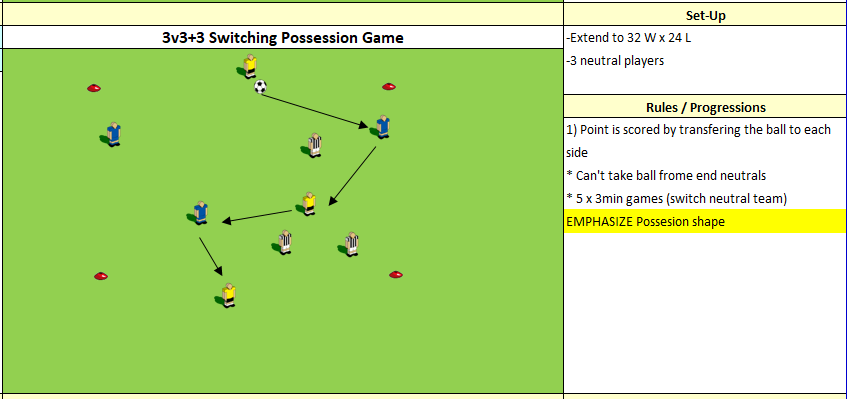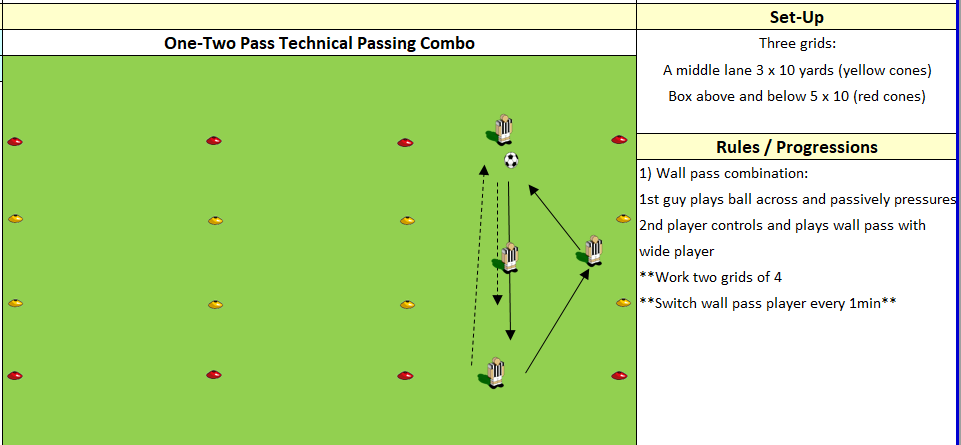U9 Training Reflection (1.20.22)
- gonzaloaobando
- Jan 21, 2022
- 5 min read
Principle: Possession
Sub-Principle: Build-Up from the Back
Sub-Sub Principle: Switching Play through a Pivot
Intro - Team Talk
Special emphasis this week in the intro team talk as we began to see what possession looks like at a high level. I sent and showed the players a video at the beginning of the practice of a Manchester City goal in which 24 passes are made before scoring. We observed and talked about several key items: the importance of spacing, direction of passes and celebrating a goal as a team.
Some players identified very well that were was various types of passes: long, short, side-ways, forwards, backwards. When we spoke about backwards passes some players said they didn't like to do that because it was a "risky" pass. Understandable, but this is where the true challenge is with this group: showing them that this collective, multi-directional way of retaining the ball is a great way to play the game.
We also emphasized what the players did after scoring: did one guy celebrate or did others come congratulate him? Slowly we need to build this team-spirit into the group.
First Part - Technical Activation

In the first part we designed a small grid with a smaller grid inside (the yellow cones) and made two teams of four with two players from each team on the opposite sides and two players in the middle. The objective here was to transfer the ball from side to side via control and pass. After the pass, the player needed to go back into the square and then check out again after his teammate performed the same sequence. The idea here was to make this reception dynamic - forcing the players to check in and out of the square. The progression then tasked the players to have to transfer the ball without the ball going through the center square so now the players had to think about angles of reception and pass. What was nice about this exercise is that two groups were going at the same time so this adds some element of passive opposition; and an element of chaos that I like to include in these technical practices.
For the future I want to insist that my assistant coach and I occupy spaces inside the activity, almost as if we are in the way, so the players have to avoid even more obstacles. Overall, the design of this activity was effective I thought.
Future task and improvements: dial-into the mechanics of turning and back-foot reception, task players with two touches.
Second Part - Technical Game
We then progressed this activity into a technical game in race format (similar to what we did on Tuesday) where the teams had to complete 3 switches before picking the ball up and huddling together. Again just little things to add some urgency to the exercise and create a fun competition. The huddling aspect is good to build team-spirit as well.
Third Part - Tactical Game

For the tactical part of the practice we designed a 3v3+2 switching possession game (we had only 8 players total). The objective of the game was to reward the switch pass, this got the team a point. I was decently surprised how quickly the players picked up the game. Teams were scoring ~5-6 switches per 3min games which was great to see. You could see some players start to think about spacing once the neutral received the ball by spreading out but this habit is still not where we need it to be. The reaction to open yourself up needs to happen faster but we will get there. For the first time playing this game, they did exceptionally well.
At times however, players tried to force the switch as opposed to maintaining possession and building up to do it. Here we need to emphasize patience and continue to play games like this. Perhaps a good future condition would be to require an x amount of passes before the switch can occur, like a two grid switching rondo game.
Final Part - SSG

In the final part we designed a conditioned 3v3+2 SSG where the neutrals operated on the sides. This gave the team in possession automatic width and allowed for a decent amount of switches of play. The shape of the players was also excellent and is what we are aiming to establish structure-wise in our game, essentially a 2-3-1. We had one less player so we worked mainly on the first two sectorial lines (i.e. the 2-3 part).
Although the players were executing switches I felt as if I could have designed a better condition to incentive the switches. I think a better condition would have been:
Ball must touch at least one wide neutral before being able to score and a goal is worth the amount of neutrals that touch the ball (i.e. if neutral touches it twice then the goal is worth 2 points, if it three times and worth 3 points). That could have been a more specific and clear reward for switching play.
Extra - Team Talk
With this group I need to work on distinguishing the difference between competing and winning. I care for the former, more so than the latter. Winning only for the sake of winning is pointless. Its about how you do it: competing. What is competing? Competing is challenging yourself, aware of the result but more focused on performance. Winning is no good if your teammates feel that you are doing it for yourself and want all the credit.
There was a player that immediately after the practice went on saying: "we won, I scored x amount of goals, etc." I like the enthusiasm but the manner in which it was said needed to be different from my point of view.
Here I needed to step in and it is in these areas I will be firm. This is not a ME sport. It is WE. I believe that most good teams at this age will be teams that have a very good ME player, maybe two. Very rare at this age will we find a good WE team. Like I mentioned at the beginning of this reflection, this is my biggest challenge with this group: showing them that the game must be played collectively. By playing together we can enable the individual qualities of our players to shine, this doesn't work the the other way around.
This will take some time but I am optimistic with this group. Good things lie ahead.
Next week
- Technical activation that allows for combination passes (especially the wall pass)
- Tactical game that rewards combinations
- A directional or end zone where scoring can only occur from a pass/combination/assist
- Two grid switching rondo game (for future practices)







コメント